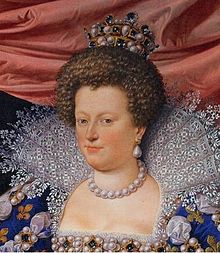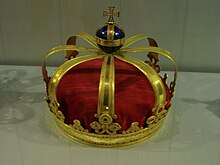Beau Sancy


The Beau Sancy is a 34.98 carat diamond. The stone was the star among the crown jewels of the Prussian Hohenzollern and was worn by the Queen of Prussia. It is also called the "little Sancy" or "le beau Sancy" and should not be confused with the larger Sancy with 55.23 carats.
The diamond is probably the first stone that was cut with an eightfold arrangement of 110 facets . It has a height of 22.3 mm and a width of 19.5 mm and is cut in the shape of a teardrop. The old silver setting from around 1600 with the golden claws is original. Later, a small, brilliant eyelet was applied.
The stone probably comes from the mines in the region of the Indian city of Golkonda , where famous diamonds such as Hope , Koh-i-Noor and Regent were found .
history
One of the first owners of the Beau Sancy was Nicolas de Harlay de Sancy , who was in the service of the French King Henry III. stood and as an ambassador to the court of Sultan Selim II acquired the diamond in Constantinople at the end of the 16th century . It was through him that the big and the little Sancy got their names. In 1589 he offered both Sancy diamonds to the Duke of Mantua , in 1596 Elizabeth I of England acquired the large stone. In 1604 the Beau Sancy was bought for only 75,000 livres (25,000 écu ) by Henry IV of France , who gave it to his wife Maria de 'Medici , and the stone was inventoried with her.
Maria de 'Medici had the Beau Sancy attached as a lace in the crown that she wore on the occasion of her coronation ceremony in 1610. As a widow, she later had to sell the stone because of her debt. It was purchased for 80,000 guilders from Friedrich Heinrich von Oranien-Nassau , its most important expenditure in the state budget of the United Netherlands in 1641. The Beau Sancy served as a bridal gift in the arranged marriage between his son Willem, who later became Willem II of Oranien-Nassau , and Maria Henrietta Stuart . She moved back to England with the jewelry after the death of her husband in 1650. In 1662 the Beau Sancy was mortgaged to pay off their debts. In 1677, on the occasion of the wedding of Willem III. of Orange-Nassau and Mary Queen of Scots , the diamond went to the bride and, when the couple ascended the throne of England in 1689, to the British Crown Jewels . Since the marriage remained childless, the house of Orange-Nassau received the jewel back after her death. In the dispute over the so-called Orange inheritance in 1702, Frederick I, King in Prussia, fought alongside a few counties for Beau Sancy and had him inserted into the Prussian royal crown with which he had crowned himself in Königsberg the previous year .
Frederick II , who refused any display of jewelery for himself, left the Beau Sancy in 1740 to his wife Elisabeth Christine at free disposal. She arranged it as the center of a loop and also in a bouquet as a pendeloque . Later on, other female members of the Prussian royal family also wore the diamond in this form on important occasions, especially when they married into the Hohenzollern family. In 1918, after the end of the monarchy in Germany, the gemstone remained in the possession of the Hohenzollern family and continued to be worn in the family.
The Beau Sancy was presented in Munich in 2005 at the exhibition “Treasury of Germany. Art in Noble Private Ownership ”is shown in the Haus der Kunst .
On May 15, 2012, the House of Hohenzollern offered the Beau Sancy to Sotheby’s in Geneva for auction, at which it was purchased for 9.04 million Swiss francs (= 7.52 million euros) from an unknown bidder.
literature
- Ian Balfour : Famous Diamonds. Collins, London 1987
- Herbert Tillander : Diamond Cuts in Historic Jewelry - 1381 to 1910. Art Books Intl., London 1995
Web links
- The Beau Sancy Diamond at famousdiamonds (English)
- Beau Sancy at royal magazin
Individual evidence
- ↑ Nicolas de Harlay sieur de Sancy see French Wikipedia fr: Nicolas de Harlay sieur de Sancy
- ↑ www.artnet.de
- ^ Beau Sancy ( Memento of April 3, 2016 in the Internet Archive ) www.wirtschaftsblatt.at

